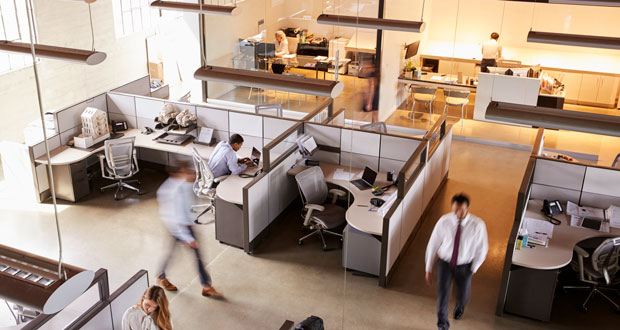As more workers return to the office to work, prompting many companies to reassess their current space allocations, a new survey commissioned by law firm Irwin Mitchell, reveals 45 per cent of UK businesses are looking to expand their office space in the next 12 to 18 months rather than to reduce it (10 per cent), whilst 64 per cent of those surveyed admit they overshot their downsizing efforts during the Covid era.
According to the Office Occupiers Survey 2025 – Office Occupiers Report 2025 of those planning to expand, 49 per cent said they would do this by reconfiguring their existing premises rather than relocating to entirely new sites (23 per cent). And in a vote for flex, 44 per cent of respondents are considering incorporating flexible workspace options in their property portfolios – perhaps creating the “breathing space” needed as they adapt to evolving operational requirements.
In-person office attendance on the up
Organisations are capitalising on a marked shift in working habits. Over the past year, 72 per cent of employers have noted an increase in office attendance, with 74 per cent predicting further growth in the next 12 to 18 months.
The survey also reveals a decisive tilt towards more days expected in the office. While 45 per cent of businesses now require employees in the office three to four days a week, a significant 35 per cent have moved to a full five-day requirement—reflecting a strong push for traditional office engagement following the pandemic.
Rising costs are the main concern for businesses
When asked about the main threats looming over the next 12 months, 43 per cent of businesses cited rising inflation and higher interest rates—factors that increase the cost of borrowing. Other concerns include escalated employment costs and risks (30 per cent), adverse tax policies (26 per cent), and mounting property costs covering energy, rent, business rates, insurance, and service charges (21 per cent).
In response to this challenging economic backdrop, companies appear to be doubling down on efforts to boost productivity by maximising the functionality of their office spaces and encouraging face to face collaboration.
Adapting Office Environments
Current office layouts are also putting pressure on firms’ ability to accommodate all their staff in one place. Only 33.5 per cent of respondents believe their existing space can handle full capacity, with 53 per cent asserting that if everyone returned to the office, they would fall short. Consequently, many companies are reassessing both the type and amount of space they require moving forward.
To entice employees back into the office, 46 per cent of businesses are integrating workplace environment and design into their broader strategies to attract and retain talent—and a further 35 per cent are considering doing so. A decisive 95 per cent have already involved HR teams in making decisions on working spaces.
In addition, 97 per cent are offering employee incentives to boost on-site attendance, including flexible hours (59 per cent), improved amenities (52 per cent), adaptable office day arrangements (50 per cent), career progression (49 per cent) and bespoke office modifications (42 per cent).
Employers are also investing in office enhancements that range from better collaborative space, communal areas, and restaurants to quiet working zones, individual pods, advanced IT facilities, and practical end-of-trip amenities such as showers and bicycle racks.
Attaining net zero and cost reduction
Businesses acknowledge the importance of sustainability in their property strategies, but cost and return on investment remain primary drivers for making changes. While 45 per cent of businesses cite expense as the biggest barrier to reducing their office’s environmental impact, many opt for lower-cost solutions such as switching to renewable energy (42 per cent), office waste reduction (40 per cent) purchasing eco-friendly office products (39 per cent) and reducing energy consumption.
When choosing new office space, energy efficiency (42 per cent) and adaptability (41 per cent) rank as top environmental criteria. Notably, 47 per cent of businesses would pay a higher rent for eco-friendly offices—but only if it comes with equivalent reductions in service charges or energy bills.
Rise in carbon emission reporting and green finance
Corporate engagement with environmental initiatives is growing. Eighty-five per cent of businesses now report on their carbon emissions policies (Scope 1, 2 and 3), with 89% per centvoluntarily doing so. While sustainability concerns play the largest reason for doing this, (54 per cent), brand image (50 per cent), client expectations (49 per cent) and anticipating this will become mandatory (34 per cent) also remain key motivators.
Interest in green financing is also rising, with 35 per cent of businesses already securing ESG-related finance and 43 per cent considering it for future investments.
Considering the overall results of the survey, Will Scott, Real Estates Disputes Partner at Irwin Mitchell said: “Our survey shows that the office and its place in the world of work continues to evolve, particularly as working patterns change.
“As rising costs and inflation impact corporate decision making and in line with the need to reduce unnecessary expenditure, businesses appreciate they need to improve the productivity of their current office space so that it can both accommodate increasing numbers of staff coming back in to work, but also one that can satisfy internal stakeholders’ needs and wishes.”
He added: “Environmental considerations play a part in this, but attitudes continue to shift away from the ‘nice to have’ towards that ‘what is necessary’ as the costs and associated benefits become clearer to see. Businesses are leaning towards more environmentally focused premises that help to drive down operational costs, whilst also supporting the demands of employees and those they do business with, whist enabling the company to avail itself of greater financing options.
“In the ‘Stay versus Go’ decision, and in tight office market supply conditions, more businesses are now considering what is probably the least expensive option for expansion – to work closely with their current landlord to rework their existing office property and possibly add in an element of flex space as and when needed, giving themselves a breathing space to think about where they want to be more permanently.”
Workplace management solutions provider, Matrix Booking, has published a new free guide on how to create workspaces that meet the demands of the current and future workforce.
For those businesses looking to encourage more employees into the office, or wanting to improve their experience overall, ‘How facilities and workplace managers can shape the office of the future’ provides insights and the tools you need to ensure your environment meets the changing nature of employee preferences, employer requests, and evolving styles of work.
To download the guide click here.





